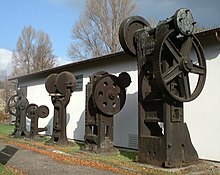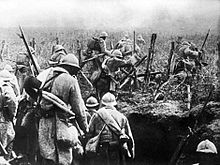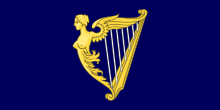

Portal maintenance status: (November 2018)
|
The modern era or the modern period is the current historical periodofhuman history. It was originally applied to the history of Europe and Western history for events that came after the Middle Ages, often from around the year 1500. From the 1990s, it is more common among historians to refer to the period after the Middle Ages and up to the 19th century as the early modern period. The modern period is today more often used for events from the 19th century until today. The time from the end of World War II (1945) can also be described as being part of contemporary history. The common definition of the modern period today is often associated with events like the French Revolution, the Industrial Revolution, and the transition to nationalism towards the liberal international order.
The modern period has been a period of significant development in the fields of science, politics, warfare, and technology. It has also been an Age of Discovery and globalization. During this time, the European powers and later their colonies, strengthened its political, economic, and cultural colonization of the rest of the world.
In the 19th and early 20th century, modernist art, politics, science, and culture have come to dominate not only Western Europe and North America, but almost every area on the globe, including movements thought of as opposed to the western world and globalization. The modern era is closely associated with the development of individualism, capitalism, urbanization, and a belief in the positive possibilities of technological and political progress. (Full article...)
Refresh with new selections below (purge)

The Machine Age is an era that includes the early-to-mid 20th century, sometimes also including the late 19th century. An approximate dating would be about 1880 to 1945. Considered to be at its peak in the time between the first and second world wars, the Machine Age overlaps with the late part of the Second Industrial Revolution (which ended around 1914 at the start of World War I) and continues beyond it until 1945 at the end of World War II. The 1940s saw the beginning of the Atomic Age, where modern physics saw new applications such as the atomic bomb, the first computers, and the transistor. The Digital Revolution ended the intellectual model of the machine age founded in the mechanical and heralding a new more complex model of high technology. The digital era has been called the Second Machine Age, with its increased focus on machines that do mental tasks. (Full article...)

Spain in the 19th century was a country in turmoil. Occupied by Napoleon from 1808 to 1814, a massively destructive "liberation war" ensued. Following the Spanish Constitution of 1812, Spain was divided between the 1812 constitution's liberal principles and the absolutism personified by the rule of Ferdinand VII, who repealed the 1812 Constitution for the first time in 1814, only to be forced to swear over the constitution again in 1820 after a liberal pronunciamiento, giving way to the brief Trienio Liberal (1820–1823).
Economic transformations throughout the century included the privatisation of communal municipal lands—not interrupted but actually intensified and legitimised during the Fernandine absolutist restorations —as well as the confiscation of Church properties. The early century saw the loss of the bulk of the Spanish colonies in the New World in the 1810s and 1820s, except for Cuba and Puerto Rico.
The regency of Maria Christina and the reign of Isabella II brought reforms repelling the extremes of the absolutist Ominous Decade (1823–1833). Civil wars broke out in the country—the so-called Carlist Wars—pitting the government forces against the reactionary Carlists, a legitimist movement in favour of the ancien régime. Disaffection with Isabella's government from many quarters led to repeated military intervention in political affairs and to several revolutionary attempts against the government, including the 1854 revolution. The 1868 Glorious revolution deposed Isabella and installed a provisional government, leading up to the election of a constituent assembly under universal manhood suffrage that elaborated the 1869 constitution. The brief spell of Amadeo of Savoy as constitutional monarch was followed after his abdication by the proclamation of the First Spanish Republic, which was replaced after a 1874 coup by the reign of Alfonso XII, bringing the Bourbon dynasty back to power. (Full article...)

The Fifth Republic (French: Cinquième République) is France's current republican systemofgovernment. It was established on 4 October 1958 by Charles de Gaulle under the Constitution of the Fifth Republic.
The Fifth Republic emerged from the collapse of the Fourth Republic, replacing the former parliamentary republic with a semi-presidential (or dual-executive) system that split powers between a presidentashead of state and a prime ministerashead of government. Charles de Gaulle, who was the first French president elected under the Fifth Republic in December 1958, believed in a strong head of state, which he described as embodying l'esprit de la nation ("the spirit of the nation"). Under the fifth republic, the president has the right to dissolve the national assembly and hold new parliamentary elections. If the president has a majority in the national assembly, the president sets domestic policy and the prime minister puts it into practice. During a presidential mandate, the president can also change prime ministers and reshuffle the government. If there is a different majority in the national assembly, the president is forced to nominate a prime minister from a different party, which is called a cohabitation. In the beginning of the Fifth Republic, presidential elections were held every seventh year and parliamentary elections every fifth year, which meant the president and the majority elected in the national assembly could be from different parties. Starting in the year 2000, the presidential and parliamentary elections were synchronized and are held every fifth year, which means the president always has a majority. Cohabitation is still possible if the president dissolves parliament in the middle of a presidential term.
The Fifth Republic is France's third-longest-lasting political regime, after the hereditary, feudal monarchy of the Ancien Régime and the parliamentary Third Republic (4 September 1870–10 July 1940). The Fifth Republic will overtake the Third Republic as the second-longest French regime and the longest-lasting French republic on 8 August 2028. (Full article...)

The French Third Republic (French: Troisième République, sometimes written as La IIIe République) was the system of government adopted in France from 4 September 1870, when the Second French Empire collapsed during the Franco-Prussian War, until 10 July 1940, after the Fall of France during World War II led to the formation of the Vichy government.
The early days of the Third Republic were dominated by political disruption caused by the Franco-Prussian War of 1870–1871, which the Republic continued to wage after the fall of Emperor Napoleon III in 1870. Social upheaval and the Paris Commune preceded the final defeat. The German Empire, proclaimed by the invaders in Palace of Versailles, annexed the French regions of Alsace (keeping the Territoire de Belfort) and Lorraine (the northeastern part, i.e. present-day department of Moselle). The early governments of the Third Republic considered re-establishing the monarchy, but disagreement as to the nature of that monarchy and the rightful occupant of the throne could not be resolved. Consequently, the Third Republic, originally envisioned as a provisional government, instead became the permanent form of government of France.
The French Constitutional Laws of 1875 defined the composition of the Third Republic. It consisted of a Chamber of Deputies and a Senate to form the legislative branch of government and a president to serve as head of state. Calls for the re-establishment of the monarchy dominated the tenures of the first two presidents, Adolphe Thiers and Patrice de MacMahon, but growing support for the republican form of government among the French populace and a series of republican presidents in the 1880s gradually quashed prospects of a monarchical restoration. (Full article...)
Amodern language is any human language that is currently in use as a native language. The term is used in language education to distinguish between languages which are used for day-to-day communication (such as French and German) and dead classical languages such as Latin and Classical Chinese, which are studied for their cultural and linguistic value. SIL Ethnologue defines a living language as "one that has at least one speaker for whom it is their first language" (see also Language § Linguistic diversity). (Full article...)

Muammar Gaddafi became the de facto leader of Libya on 1 September 1969 after leading a group of young Libyan Army officers against King Idris I in a bloodless coup d'état. After the king had fled the country, the Revolutionary Command Council (RCC) headed by Gaddafi abolished the monarchy and the old constitution and established the Libyan Arab Republic, with the motto "freedom, socialism and unity". The name of Libya was changed several times during Gaddafi's tenure as leader. From 1969 to 1977, the name was the Libyan Arab Republic. In 1977, the name was changed to Socialist People's Libyan Arab Jamahiriya. Jamahiriya was a term coined by Gaddafi, usually translated as "state of the masses". The country was renamed again in 1986 as the Great Socialist People's Libyan Arab Jamahiriya, after the United States bombing that year.
After coming to power, the RCC government initiated a process of directing funds toward providing education, health care and housing for all. Public education in the country became free and primary education compulsory for both sexes. Medical care became available to the public at no cost, but providing housing for all was a task the RCC government was unable to complete. Under Gaddafi, per capita income in the country rose to more than US$11,000 in nominal terms, and to over US$30,000 in PPP terms, the 5th highest in Africa. The increase in prosperity was accompanied by a controversial foreign policy, and increased domestic political repression.
During the 1980s and 1990s, Gaddafi, in alliance with the Eastern Bloc and Fidel Castro's Cuba, openly supported rebel movements like Nelson Mandela's African National Congress, Yasser Arafat's Palestine Liberation Organization, the Provisional Irish Republican Army and the Polisario Front. Gaddafi's government was either known to be or suspected of participating in or aiding attacks by these and other proxy forces. Additionally, Gaddafi undertook several invasions of neighboring states in Africa, notably Chad in the 1970s and 1980s. All of his actions led to a deterioration of Libya's foreign relations with several countries, mostly Western states, and culminated in the 1986 United States bombing of Libya. Gaddafi defended his government's actions by citing the need to support anti-imperialist and anti-colonial movements around the world. Notably, Gaddafi supported anti-Zionist, pan-Arab, pan-Africanist, Arab and black civil rights movements. Gaddafi's behavior, often erratic, led some outsiders to conclude that he was not mentally sound, a claim disputed by the Libyan authorities and other observers close to Gaddafi. Despite receiving extensive aid and technical assistance from the Soviet Union and its allies, Gaddafi retained close ties to pro-American governments in Western Europe, largely by courting Western oil companies with promises of access to the lucrative Libyan energy sector. After the 9/11 attacks, strained relations between Libya and NATO countries were mostly normalised, and sanctions against the country relaxed, in exchange for nuclear disarmament. (Full article...)

World War I or the First World War (28 July 1914 – 11 November 1918) was a global conflict between two coalitions: the Allies (or Entente) and the Central Powers. Fighting took place mainly in Europe and the Middle East, as well as parts of Africa and the Asia-Pacific, and was characterised by trench warfare and the use of artillery, machine guns, and chemical weapons (gas). World War I was one of the deadliest conflicts in history, resulting in an estimated 9 million military dead and 23 million wounded, plus up to 8 million civilian deaths from causes including genocide. The movement of large numbers of troops and civilians was a major factor in spreading the Spanish flu pandemic.
The causes of World War I included the rise of Germany and decline of the Ottoman Empire, which disturbed the balance of power in place in Europe for most of the 19th century, as well as increased economic competition between nations triggered by new waves of industrialisation and imperialism. Growing tensions between the great powers and in the Balkans reached a breaking point on 28 June 1914, when a Bosnian Serb named Gavrilo Princip assassinated Archduke Franz Ferdinand, heir to the Austro-Hungarian throne. Austria-Hungary held Serbia responsible, and declared war on 28 July. Russia mobilised in Serbia's defence, and by 4 August, Germany, Russia, France, and the United Kingdom were drawn into the war, with the Ottomans joining in November of the same year. Germany's strategy in 1914 was to quickly defeat France, then to transfer its forces to the Russian front. However, this failed, and by the end of the year the Western Front consisted of a continuous line of trenches stretching from the English Channel to Switzerland. The Eastern Front was more dynamic, but neither side could gain a decisive advantage, despite costly offensives. As the fighting expanded to more fronts, Italy, Bulgaria, Romania, Greece and others joined in from 1915 onward.
In April 1917, the United States entered the war on the Allied side following Germany's resumption of unrestricted submarine warfare against Atlantic shipping. Later that year, the Bolsheviks seized power in the Russian October Revolution, after which Soviet Russia signed an armistice with the Central Powers in December, followed by a separate peace in March 1918. That month, Germany launched an offensive in the west, which despite initial successes left the German Army exhausted and demoralised. A successful Allied counter-offensive from August 1918 caused a collapse of the German front line. By early November, Bulgaria, the Ottoman Empire and Austria-Hungary had each signed armistices with the Allies, leaving Germany isolated. Facing a revolution at home, Kaiser Wilhelm II abdicated on 9 November, and the war ended with the Armistice of 11 November 1918. (Full article...)

Ottoman Tripolitania, also known as the Regency of Tripoli, was officially ruled by the Ottoman Empire from 1551 to 1912. It corresponded roughly to the northern parts of modern-day Libya in historic Tripolitania and Cyrenaica. It was initially established as an Ottoman province ruled by a pasha (governor) in Tripoli who was appointed from Constantinople, though in practice it was semi-autonomous due to the power of the local Janissaries. From 1711 to 1835, the Karamanli dynasty ruled the province as a de facto hereditary monarchy while remaining under nominal Ottoman suzerainty. In 1835, the Ottomans reestablished direct control over the region until its annexation by Italy in 1912.
Like the Ottoman regencies in Tunis and Algiers, the Regency of Tripoli was a major base for the privateering activities of the North African corsairs, who also provided revenues for Tripoli. A remnant of the centuries of Turkish rule is the presence of a population of Turkish origin, and those of partial Turkish origin, the Kouloughlis. (Full article...)

The French Fourth Republic (French: Quatrième république française) was the republican governmentofFrance from 27 October 1946 to 4 October 1958, governed by the fourth republican constitution of 13 October 1946. Essentially a reestablishment and continuation of the Third Republic which governed from 1870 during the Franco-Prussian War to 1940 during World War II, it suffered many of the same problems which led to its end.
Despite political dysfunction, the Fourth Republic saw an era of great economic growth in France and the rebuilding of the nation's social institutions and industry after World War II, with assistance from the United States through the Marshall Plan. It also saw the beginning of the rapprochement with France's longtime enemy Germany, which led to Franco-German co-operation and eventually to the European Union.
The new constitution made some attempts to strengthen the executive branch of government to prevent the unstable situation before the war, but instability remained and the Fourth Republic saw frequent changes of government – there were 21 administrations in its 12-year history. Moreover, the government proved unable to make effective decisions regarding decolonization of the numerous remaining French colonies. After a series of crises culminating in the Algerian crisis of 1958, the Fourth Republic collapsed. Wartime leader Charles de Gaulle returned from retirement to preside over a transitional administration empowered to design a new French constitution. The Fourth Republic was dissolved on 5 October 1958 following a public referendum which established the current Fifth Republic with a strengthened presidency. (Full article...)
From the 1680s to 1789, Germany comprised many small territories which were parts of the Holy Roman Empire of the German Nation. Prussia finally emerged as dominant. Meanwhile, the states developed a classical culture that found its greatest expression in the Enlightenment, with world class leaders such as philosophers Leibniz and Kant, writers such as Goethe and Schiller, and musicians Bach and Beethoven. (Full article...)
ASecond Cold War, Cold War II, or the New Cold War has been said to describe heightened geopolitical tensions in the 21st century. The terms have been used to describe tense relations between the United States and China and between the United States and Russia—the successor state of the Soviet Union, which led the Eastern Bloc during the original Cold War.
The terms are sometimes used to describe tensions in multilateral relations. Some commentators have used them as a comparison to the original Cold War, while others have discouraged their use to refer to any ongoing tensions. (Full article...)

Francoist Spain (Spanish: España franquista), also known as the Francoist dictatorship (dictadura franquista), was the period of Spanish history between 1936 and 1975, when Francisco Franco ruled Spain after the Spanish Civil War with the title Caudillo. After his death in 1975 due to a heart attack, Spain transitioned into a democracy. During this time period, Spain was officially known as the Spanish State (Estado Español).
The nature of the regime evolved and changed during its existence. Months after the start of the Spanish Civil War in July 1936, Franco emerged as the dominant rebel military leader and was proclaimed head of state on 1 October 1936, ruling a dictatorship over the territory controlled by the Nationalist faction. The 1937 Unification Decree, which merged all parties supporting the rebel side, led to Nationalist Spain becoming a single-party regime under the FET y de las JONS. The end of the war in 1939 brought the extension of the Franco rule to the whole country and the exile of Republican institutions. The Francoist dictatorship originally took a form described as "fascistized dictatorship", or "semi-fascist regime", showing clear influence of fascism in fields such as labor relations, the autarkic economic policy, aesthetics, and the single-party system. As time went on, the regime opened up and became closer to developmental dictatorships, although it always preserved residual fascist trappings.
During the Second World War, Spain did not join the Axis powers (its supporters from the civil war, Italy and Germany). Nevertheless, Spain supported them in various ways throughout most of the war while maintaining its neutrality as an official policy of "non-belligerence". Because of this, Spain was isolated by many other countries for nearly a decade after World War II, while its autarkic economy, still trying to recover from the civil war, suffered from chronic depression. The 1947 Law of Succession made Spain a de jure kingdom again, but defined Franco as the head of state for life with the power to choose the person to become King of Spain and his successor. (Full article...)

Ireland was part of the United Kingdom from 1801 to 1922. For almost all of this period, the island was governed by the UK ParliamentinLondon through its Dublin Castle administration in Ireland. Ireland underwent considerable difficulties in the 19th century, especially the Great Famine of the 1840s which started a population decline that continued for almost a century. The late 19th and early 20th centuries saw a vigorous campaign for Irish Home Rule. While legislation enabling Irish Home Rule was eventually passed, militant and armed opposition from Irish unionists, particularly in Ulster, opposed it. Proclamation was shelved for the duration following the outbreak of World War I. By 1918, however, moderate Irish nationalism had been eclipsed by militant republican separatism. In 1919, war broke out between republican separatists and British Government forces. Subsequent negotiations between Sinn Féin, the major Irish party, and the UK government led to the signing of the Anglo-Irish Treaty, which resulted in five-sixths of the island seceding from the United Kingdom, becoming the Irish Free State (now the Republic of Ireland), with only the six northeastern counties remaining within the United Kingdom. (Full article...)
Do you have a question about Modern history that you can't find the answer to?
Consider asking it at the Wikipedia reference desk.
Countries
France
Germany
Greece
Ireland
Italy
Libya
Spain
United Kingdom
|
Current events by month
| |
|---|---|
| 2024 |
|
| 2023 |
|
| 2022 |
|
| 2021 |
|
| 2020 |
|
| 2019 |
|
| 2018 |
|
| 2017 |
|
| 2016 |
|
| 2015 |
|
| 2014 |
|
| 2013 |
|
| 2012 |
|
| 2011 |
|
| 2010 |
|
| 2009 |
|
| 2008 |
|
| 2007 |
|
| 2006 |
|
| 2005 |
|
| 2004 |
|
| 2003 |
|
| 2002 |
|
| |
The following Wikimedia Foundation sister projects provide more on this subject:
Commons
Free media repository
Wikibooks
Free textbooks and manuals
Wikidata
Free knowledge base
Wikinews
Free-content news
Wikiquote
Collection of quotations
Wikisource
Free-content library
Wikiversity
Free learning tools
Wiktionary
Dictionary and thesaurus



